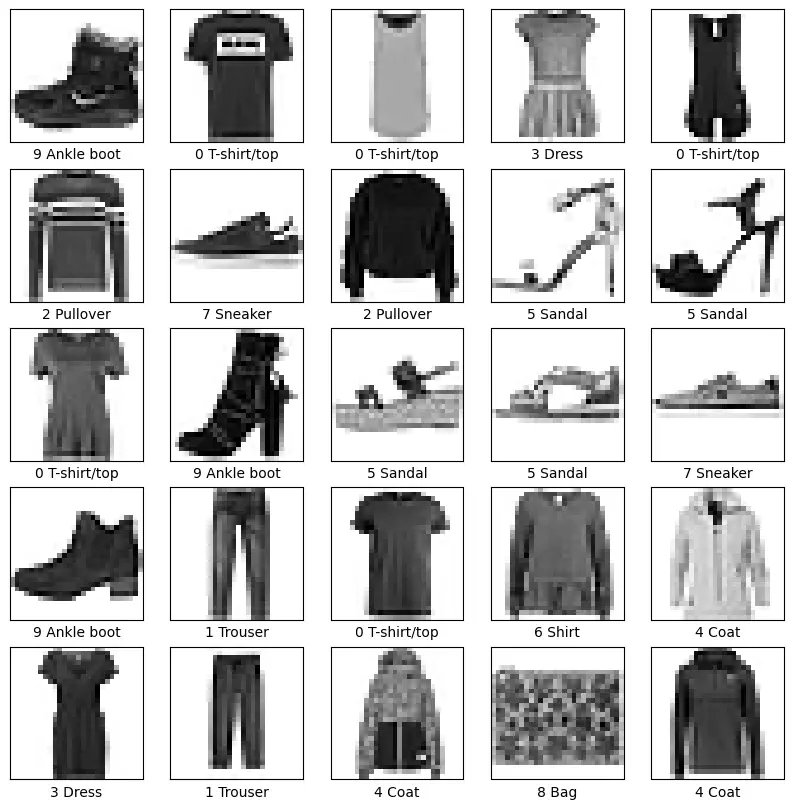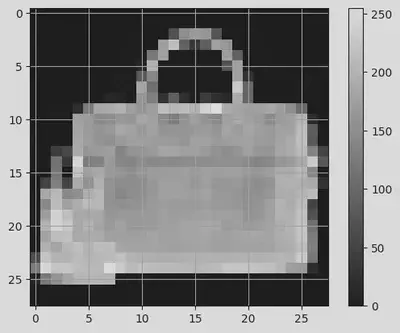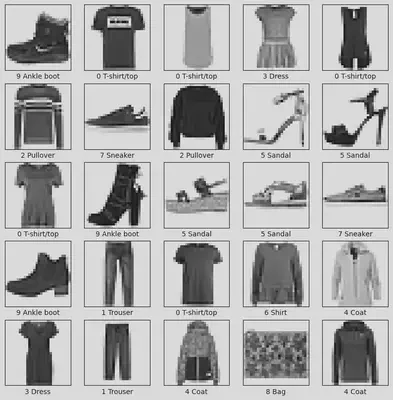Image classification using NN
Performing Image Classification on Fashion MNIST Dataset
 Program output
Program outputImage Classification using Fashion MNIST Dataset
Table of Contents
- Aim
- Prerequisite
- Steps
- Step 1: Load the Fashion MNIST dataset into your notebook
- Step 2: Pre-processing and prepare the data for giving to the neural network
- Step 3: Building the sequential neural network model
- Step 4: Compile and fit the model to the training dataset
- Step 5: Apply regularization and see the effect on the performance
- Step 6: Use different optimizers and record the best performance
Aim
To perform image classification on the Fashion MNIST dataset using a neural network.
Prerequisite
- Python Programming
- Keras
- TensorFlow
- Numpy
Steps
Step 1: Load the Fashion MNIST dataset into your notebook
Load the Fashion MNIST dataset to begin the data processing and modeling steps.
- Load it using
from keras.datasets import fashion_mnist
Step 2: Pre-processing and prepare the data for giving to the neural network
Step 2a: Explore the dataset
Explore the dataset to understand its structure and the type of data it contains.
Step 2b: Determine the number of classes
Identify the number of unique classes in the dataset to guide the model architecture.
Step 2c: Normalize the dataset and flatten it to be suitable for applying to an ANN
Normalize the feature values to ensure they fall within a specific range and flatten the images to be compatible with an Artificial Neural Network (ANN).
Step 2d: Split the dataset into train and test
Split the dataset into training and testing sets to evaluate the model’s performance.
Step 3: Building the sequential neural network model
Step 3a: You may choose the layers
Select and add layers to the sequential neural network model as per requirement.
Step 3b: Use appropriate activation and loss functions
Choose suitable activation and loss functions for the neural network.
Step 4: Compile and fit the model to the training dataset
Compile and fit the model to the training dataset, and include validation data in the process.
Step 5: Apply regularization and see the effect on the performance
Apply regularization techniques such as L2 regularization or dropout to the model and observe their effects on performance.
Step 6: Use different optimizers and record the best performance
Experiment with different optimizers like SGD, Momentum-based optimizer, Adagrad, Adam, and RMSprop. Record and compare their performances to determine the best optimizer for your model.
# import libraries
import matplotlib.pyplot as plt
import pandas as pd
import numpy as np
from keras.datasets import fashion_mnist
from sklearn.model_selection import train_test_split
from keras.models import Sequential
from keras.layers import Dense, Dropout
Task 1: Load the fashion mnist dataset into your notebook. The dataset is available in Keras.
a. Load it using from keras.datasets import fashion_mnist
(train_images, train_labels), (test_images, test_labels) = fashion_mnist.load_data()
Task 2: Pre-processing and prepare the data for giving to the neural network.
a. Explore the dataset (Performing standard EDA operations).
train_images
array([[[0, 0, 0, ..., 0, 0, 0],
[0, 0, 0, ..., 0, 0, 0],
[0, 0, 0, ..., 0, 0, 0],
...,
[0, 0, 0, ..., 0, 0, 0],
[0, 0, 0, ..., 0, 0, 0],
[0, 0, 0, ..., 0, 0, 0]],
[[0, 0, 0, ..., 0, 0, 0],
[0, 0, 0, ..., 0, 0, 0],
[0, 0, 0, ..., 0, 0, 0],
...,
[0, 0, 0, ..., 0, 0, 0],
[0, 0, 0, ..., 0, 0, 0],
[0, 0, 0, ..., 0, 0, 0]],
[[0, 0, 0, ..., 0, 0, 0],
[0, 0, 0, ..., 0, 0, 0],
[0, 0, 0, ..., 0, 0, 0],
...,
[0, 0, 0, ..., 0, 0, 0],
[0, 0, 0, ..., 0, 0, 0],
[0, 0, 0, ..., 0, 0, 0]],
...,
[[0, 0, 0, ..., 0, 0, 0],
[0, 0, 0, ..., 0, 0, 0],
[0, 0, 0, ..., 0, 0, 0],
...,
[0, 0, 0, ..., 0, 0, 0],
[0, 0, 0, ..., 0, 0, 0],
[0, 0, 0, ..., 0, 0, 0]],
[[0, 0, 0, ..., 0, 0, 0],
[0, 0, 0, ..., 0, 0, 0],
[0, 0, 0, ..., 0, 0, 0],
...,
[0, 0, 0, ..., 0, 0, 0],
[0, 0, 0, ..., 0, 0, 0],
[0, 0, 0, ..., 0, 0, 0]],
[[0, 0, 0, ..., 0, 0, 0],
[0, 0, 0, ..., 0, 0, 0],
[0, 0, 0, ..., 0, 0, 0],
...,
[0, 0, 0, ..., 0, 0, 0],
[0, 0, 0, ..., 0, 0, 0],
[0, 0, 0, ..., 0, 0, 0]]], dtype=uint8)
test_images
array([[[0, 0, 0, ..., 0, 0, 0],
[0, 0, 0, ..., 0, 0, 0],
[0, 0, 0, ..., 0, 0, 0],
...,
[0, 0, 0, ..., 0, 0, 0],
[0, 0, 0, ..., 0, 0, 0],
[0, 0, 0, ..., 0, 0, 0]],
[[0, 0, 0, ..., 0, 0, 0],
[0, 0, 0, ..., 0, 0, 0],
[0, 0, 0, ..., 0, 0, 0],
...,
[0, 0, 0, ..., 0, 0, 0],
[0, 0, 0, ..., 0, 0, 0],
[0, 0, 0, ..., 0, 0, 0]],
[[0, 0, 0, ..., 0, 0, 0],
[0, 0, 0, ..., 0, 0, 0],
[0, 0, 0, ..., 0, 0, 0],
...,
[0, 0, 0, ..., 0, 0, 0],
[0, 0, 0, ..., 0, 0, 0],
[0, 0, 0, ..., 0, 0, 0]],
...,
[[0, 0, 0, ..., 0, 0, 0],
[0, 0, 0, ..., 0, 0, 0],
[0, 0, 0, ..., 0, 0, 0],
...,
[0, 0, 0, ..., 0, 0, 0],
[0, 0, 0, ..., 0, 0, 0],
[0, 0, 0, ..., 0, 0, 0]],
[[0, 0, 0, ..., 0, 0, 0],
[0, 0, 0, ..., 0, 0, 0],
[0, 0, 0, ..., 0, 0, 0],
...,
[0, 0, 0, ..., 0, 0, 0],
[0, 0, 0, ..., 0, 0, 0],
[0, 0, 0, ..., 0, 0, 0]],
[[0, 0, 0, ..., 0, 0, 0],
[0, 0, 0, ..., 0, 0, 0],
[0, 0, 0, ..., 0, 0, 0],
...,
[0, 0, 0, ..., 0, 0, 0],
[0, 0, 0, ..., 0, 0, 0],
[0, 0, 0, ..., 0, 0, 0]]], dtype=uint8)
class_names = ['T-shirt/top', 'Trouser', 'Pullover', 'Dress', 'Coat', 'Sandal', 'Shirt', 'Sneaker', 'Bag', 'Ankle boot']
print(class_names)
['T-shirt/top', 'Trouser', 'Pullover', 'Dress', 'Coat', 'Sandal', 'Shirt', 'Sneaker', 'Bag', 'Ankle boot']
index = 1010
plt.imshow(train_images[index], cmap='gray') # printing 1010th image
plt.colorbar()
plt.grid(True)
plt.show()
print("Class ID: %s and Class name: %s" % (train_labels[index], class_names[train_labels[index]]))

Class ID: 8 and Class name: Bag
# Exploring first 25 images of the dataset:
plt.figure(figsize=(10, 10))
for i in range(25): # 25 images
plt.subplot(5, 5, i + 1) # matrix of 5 X 5 array
plt.xticks([])
plt.yticks([])
plt.grid(False)
plt.imshow(train_images[i], cmap=plt.cm.binary) # printing binary/black and white image
plt.xlabel("%s %s" % (train_labels[i], class_names[train_labels[i]])) # Assigning name to each image
plt.show()

print("Shape of Training images:", train_images.shape)
print("Shape of Testing images:", test_images.shape)
print("Number of classes present in the dataset:", len(set(train_labels)))
Shape of Training images: (60000, 28, 28)
Shape of Testing images: (10000, 28, 28)
Number of classes present in the dataset: 10
b. Determine the number of classes
c. Normalize the dataset and flatten it to be suitable for applying to a ANN.
train_images = train_images / 255.0
test_images = test_images / 255.0
train_images = train_images.reshape(train_images.shape[0], -1)
test_images = test_images.reshape(test_images.shape[0], -1)
train_images
array([[0., 0., 0., ..., 0., 0., 0.],
[0., 0., 0., ..., 0., 0., 0.],
[0., 0., 0., ..., 0., 0., 0.],
...,
[0., 0., 0., ..., 0., 0., 0.],
[0., 0., 0., ..., 0., 0., 0.],
[0., 0., 0., ..., 0., 0., 0.]])
test_images
array([[0., 0., 0., ..., 0., 0., 0.],
[0., 0., 0., ..., 0., 0., 0.],
[0., 0., 0., ..., 0., 0., 0.],
...,
[0., 0., 0., ..., 0., 0., 0.],
[0., 0., 0., ..., 0., 0., 0.],
[0., 0., 0., ..., 0., 0., 0.]])
d. Split the dataset into train and split.
X_train, X_val, y_train, y_val = train_test_split(train_images, train_labels, test_size=0.2, random_state=42)
Task 3: Building the sequential neural network model.
a. You may choose the layers.
b. Use appropriate activation and loss functions.
model = Sequential()
model.add(Dense(128, activation='relu', input_shape=(784,)))
model.add(Dropout(0.5))
model.add(Dense(64, activation='relu'))
model.add(Dense(10, activation='softmax'))
Task 4: Compile and fit the model to the training dataset. Use validation also.
model.compile(optimizer='adam', loss='sparse_categorical_crossentropy', metrics=['accuracy'])
history = model.fit(X_train, y_train, epochs=10, batch_size=64, validation_data=(X_val, y_val))
Epoch 1/10
750/750 [==============================] - 5s 5ms/step - loss: 0.3670 - accuracy: 0.8625 - val_loss: 0.3446 - val_accuracy: 0.8725
Epoch 2/10
750/750 [==============================] - 3s 5ms/step - loss: 0.3604 - accuracy: 0.8664 - val_loss: 0.3358 - val_accuracy: 0.8790
Epoch 3/10
750/750 [==============================] - 3s 4ms/step - loss: 0.3589 - accuracy: 0.8659 - val_loss: 0.3439 - val_accuracy: 0.8779
Epoch 4/10
750/750 [==============================] - 3s 4ms/step - loss: 0.3528 - accuracy: 0.8679 - val_loss: 0.3386 - val_accuracy: 0.8797
Epoch 5/10
750/750 [==============================] - 3s 5ms/step - loss: 0.3478 - accuracy: 0.8694 - val_loss: 0.3359 - val_accuracy: 0.8781
Epoch 6/10
750/750 [==============================] - 4s 5ms/step - loss: 0.3466 - accuracy: 0.8719 - val_loss: 0.3348 - val_accuracy: 0.8813
Epoch 7/10
750/750 [==============================] - 3s 4ms/step - loss: 0.3395 - accuracy: 0.8732 - val_loss: 0.3271 - val_accuracy: 0.8817
Epoch 8/10
750/750 [==============================] - 3s 5ms/step - loss: 0.3377 - accuracy: 0.8746 - val_loss: 0.3325 - val_accuracy: 0.8791
Epoch 9/10
750/750 [==============================] - 3s 4ms/step - loss: 0.3346 - accuracy: 0.8746 - val_loss: 0.3309 - val_accuracy: 0.8789
Epoch 10/10
750/750 [==============================] - 3s 5ms/step - loss: 0.3267 - accuracy: 0.8772 - val_loss: 0.3279 - val_accuracy: 0.8809
model.summary()
Model: "sequential_18"
_________________________________________________________________
Layer (type) Output Shape Param #
=================================================================
dense_54 (Dense) (None, 128) 100480
dropout_21 (Dropout) (None, 128) 0
dense_55 (Dense) (None, 64) 8256
dense_56 (Dense) (None, 10) 650
=================================================================
Total params: 109386 (427.29 KB)
Trainable params: 109386 (427.29 KB)
Non-trainable params: 0 (0.00 Byte)
_________________________________________________________________
Task 5: Apply regularization and see the effect on the performance.
# Build the sequential neural network model with dropout layers
model = Sequential()
model.add(Dense(128, activation='relu', input_shape=(784,)))
model.add(Dropout(0.5)) # Add dropout with a rate of 0.5
model.add(Dense(64, activation='relu'))
model.add(Dropout(0.5)) # Add dropout with a rate of 0.5
model.add(Dense(10, activation='softmax'))
# Compile the model
model.compile(optimizer='adam', loss='sparse_categorical_crossentropy', metrics=['accuracy'])
# Fitting the model to the training dataset
history = model.fit(X_train, y_train, epochs=10, batch_size=64, validation_data=(X_val, y_val))
Epoch 1/10
750/750 [==============================] - 5s 5ms/step - loss: 0.9129 - accuracy: 0.6748 - val_loss: 0.4996 - val_accuracy: 0.8191
Epoch 2/10
750/750 [==============================] - 3s 4ms/step - loss: 0.6023 - accuracy: 0.7881 - val_loss: 0.4508 - val_accuracy: 0.8380
Epoch 3/10
750/750 [==============================] - 4s 5ms/step - loss: 0.5442 - accuracy: 0.8102 - val_loss: 0.4092 - val_accuracy: 0.8482
Epoch 4/10
750/750 [==============================] - 3s 4ms/step - loss: 0.5156 - accuracy: 0.8205 - val_loss: 0.4017 - val_accuracy: 0.8558
Epoch 5/10
750/750 [==============================] - 3s 4ms/step - loss: 0.4957 - accuracy: 0.8264 - val_loss: 0.3933 - val_accuracy: 0.8566
Epoch 6/10
750/750 [==============================] - 3s 4ms/step - loss: 0.4790 - accuracy: 0.8326 - val_loss: 0.3818 - val_accuracy: 0.8572
Epoch 7/10
750/750 [==============================] - 3s 4ms/step - loss: 0.4661 - accuracy: 0.8362 - val_loss: 0.3886 - val_accuracy: 0.8604
Epoch 8/10
750/750 [==============================] - 3s 4ms/step - loss: 0.4518 - accuracy: 0.8430 - val_loss: 0.3801 - val_accuracy: 0.8668
Epoch 9/10
750/750 [==============================] - 3s 4ms/step - loss: 0.4535 - accuracy: 0.8404 - val_loss: 0.3802 - val_accuracy: 0.8615
Epoch 10/10
750/750 [==============================] - 3s 4ms/step - loss: 0.4392 - accuracy: 0.8459 - val_loss: 0.3634 - val_accuracy: 0.8700
model.summary()
Model: "sequential_19"
_________________________________________________________________
Layer (type) Output Shape Param #
=================================================================
dense_57 (Dense) (None, 128) 100480
dropout_22 (Dropout) (None, 128) 0
dense_58 (Dense) (None, 64) 8256
dropout_23 (Dropout) (None, 64) 0
dense_59 (Dense) (None, 10) 650
=================================================================
Total params: 109386 (427.29 KB)
Trainable params: 109386 (427.29 KB)
Non-trainable params: 0 (0.00 Byte)
_________________________________________________________________
Task 6: Use different optimizers like SGD, Momentum based optimizer, Adagrad, adam and rmsprop. Record the best performance.
# Optimizer options: 'sgd', 'adam', 'adagrad', 'rmsprop', etc.
optimizer_options = ['sgd', 'adam', 'adagrad', 'rmsprop']
best_accuracy = 0
best_optimizer = None
for optimizer in optimizer_options:
model = Sequential()
model.add(Dense(128, activation='relu', input_shape=(784,)))
model.add(Dropout(0.5))
model.add(Dense(64, activation='relu'))
model.add(Dense(10, activation='softmax'))
model.compile(optimizer=optimizer, loss='sparse_categorical_crossentropy', metrics=['accuracy'])
history = model.fit(X_train, y_train, epochs=10, batch_size=64, validation_data=(X_val, y_val))
val_accuracy = history.history['val_accuracy'][-1]
if val_accuracy > best_accuracy:
best_accuracy = val_accuracy
best_optimizer = optimizer
print("Best optimizer:", best_optimizer)
print("Best validation accuracy:", best_accuracy)
Epoch 1/10
750/750 [==============================] - 4s 5ms/step - loss: 1.1964 - accuracy: 0.5760 - val_loss: 0.7355 - val_accuracy: 0.7388
Epoch 2/10
750/750 [==============================] - 3s 4ms/step - loss: 0.7699 - accuracy: 0.7289 - val_loss: 0.6125 - val_accuracy: 0.7868
Epoch 3/10
750/750 [==============================] - 3s 4ms/step - loss: 0.6654 - accuracy: 0.7718 - val_loss: 0.5514 - val_accuracy: 0.8144
Epoch 4/10
750/750 [==============================] - 3s 4ms/step - loss: 0.6107 - accuracy: 0.7874 - val_loss: 0.5140 - val_accuracy: 0.8213
Epoch 5/10
750/750 [==============================] - 3s 4ms/step - loss: 0.5702 - accuracy: 0.8029 - val_loss: 0.4845 - val_accuracy: 0.8294
Epoch 6/10
750/750 [==============================] - 3s 4ms/step - loss: 0.5455 - accuracy: 0.8110 - val_loss: 0.4648 - val_accuracy: 0.8338
Epoch 7/10
750/750 [==============================] - 3s 4ms/step - loss: 0.5250 - accuracy: 0.8174 - val_loss: 0.4553 - val_accuracy: 0.8369
Epoch 8/10
750/750 [==============================] - 3s 4ms/step - loss: 0.5092 - accuracy: 0.8208 - val_loss: 0.4384 - val_accuracy: 0.8417
Epoch 9/10
750/750 [==============================] - 3s 4ms/step - loss: 0.4894 - accuracy: 0.8266 - val_loss: 0.4302 - val_accuracy: 0.8436
Epoch 10/10
750/750 [==============================] - 3s 4ms/step - loss: 0.4821 - accuracy: 0.8305 - val_loss: 0.4184 - val_accuracy: 0.8476
Epoch 1/10
750/750 [==============================] - 4s 5ms/step - loss: 0.6828 - accuracy: 0.7544 - val_loss: 0.4596 - val_accuracy: 0.8281
Epoch 2/10
750/750 [==============================] - 3s 5ms/step - loss: 0.4951 - accuracy: 0.8209 - val_loss: 0.4055 - val_accuracy: 0.8553
Epoch 3/10
750/750 [==============================] - 3s 4ms/step - loss: 0.4503 - accuracy: 0.8352 - val_loss: 0.3845 - val_accuracy: 0.8593
Epoch 4/10
750/750 [==============================] - 3s 4ms/step - loss: 0.4371 - accuracy: 0.8410 - val_loss: 0.3661 - val_accuracy: 0.8638
Epoch 5/10
750/750 [==============================] - 4s 5ms/step - loss: 0.4130 - accuracy: 0.8474 - val_loss: 0.3649 - val_accuracy: 0.8614
Epoch 6/10
750/750 [==============================] - 3s 5ms/step - loss: 0.4021 - accuracy: 0.8529 - val_loss: 0.3525 - val_accuracy: 0.8690
Epoch 7/10
750/750 [==============================] - 4s 5ms/step - loss: 0.3922 - accuracy: 0.8544 - val_loss: 0.3459 - val_accuracy: 0.8734
Epoch 8/10
750/750 [==============================] - 4s 5ms/step - loss: 0.3826 - accuracy: 0.8596 - val_loss: 0.3394 - val_accuracy: 0.8770
Epoch 9/10
750/750 [==============================] - 3s 4ms/step - loss: 0.3753 - accuracy: 0.8612 - val_loss: 0.3441 - val_accuracy: 0.8737
Epoch 10/10
750/750 [==============================] - 3s 4ms/step - loss: 0.3678 - accuracy: 0.8625 - val_loss: 0.3368 - val_accuracy: 0.8735
Epoch 1/10
750/750 [==============================] - 4s 5ms/step - loss: 1.8003 - accuracy: 0.3894 - val_loss: 1.2433 - val_accuracy: 0.6545
Epoch 2/10
750/750 [==============================] - 3s 4ms/step - loss: 1.2379 - accuracy: 0.5801 - val_loss: 0.9591 - val_accuracy: 0.6839
Epoch 3/10
750/750 [==============================] - 3s 4ms/step - loss: 1.0488 - accuracy: 0.6350 - val_loss: 0.8430 - val_accuracy: 0.7172
Epoch 4/10
750/750 [==============================] - 3s 4ms/step - loss: 0.9521 - accuracy: 0.6679 - val_loss: 0.7814 - val_accuracy: 0.7336
Epoch 5/10
750/750 [==============================] - 3s 4ms/step - loss: 0.8879 - accuracy: 0.6911 - val_loss: 0.7398 - val_accuracy: 0.7485
Epoch 6/10
750/750 [==============================] - 3s 4ms/step - loss: 0.8466 - accuracy: 0.7073 - val_loss: 0.7069 - val_accuracy: 0.7594
Epoch 7/10
750/750 [==============================] - 3s 4ms/step - loss: 0.8128 - accuracy: 0.7207 - val_loss: 0.6833 - val_accuracy: 0.7667
Epoch 8/10
750/750 [==============================] - 3s 4ms/step - loss: 0.7804 - accuracy: 0.7332 - val_loss: 0.6640 - val_accuracy: 0.7733
Epoch 9/10
750/750 [==============================] - 3s 4ms/step - loss: 0.7569 - accuracy: 0.7410 - val_loss: 0.6463 - val_accuracy: 0.7792
Epoch 10/10
750/750 [==============================] - 3s 4ms/step - loss: 0.7367 - accuracy: 0.7464 - val_loss: 0.6321 - val_accuracy: 0.7836
Epoch 1/10
750/750 [==============================] - 4s 4ms/step - loss: 0.6966 - accuracy: 0.7516 - val_loss: 0.4577 - val_accuracy: 0.8330
Epoch 2/10
750/750 [==============================] - 3s 4ms/step - loss: 0.5022 - accuracy: 0.8192 - val_loss: 0.4050 - val_accuracy: 0.8530
Epoch 3/10
750/750 [==============================] - 3s 4ms/step - loss: 0.4600 - accuracy: 0.8364 - val_loss: 0.3938 - val_accuracy: 0.8578
Epoch 4/10
750/750 [==============================] - 3s 4ms/step - loss: 0.4417 - accuracy: 0.8408 - val_loss: 0.3840 - val_accuracy: 0.8624
Epoch 5/10
750/750 [==============================] - 3s 4ms/step - loss: 0.4272 - accuracy: 0.8470 - val_loss: 0.3655 - val_accuracy: 0.8698
Epoch 6/10
750/750 [==============================] - 3s 4ms/step - loss: 0.4146 - accuracy: 0.8517 - val_loss: 0.3713 - val_accuracy: 0.8654
Epoch 7/10
750/750 [==============================] - 3s 4ms/step - loss: 0.4056 - accuracy: 0.8566 - val_loss: 0.3747 - val_accuracy: 0.8708
Epoch 8/10
750/750 [==============================] - 3s 4ms/step - loss: 0.4005 - accuracy: 0.8568 - val_loss: 0.3567 - val_accuracy: 0.8724
Epoch 9/10
750/750 [==============================] - 3s 4ms/step - loss: 0.3931 - accuracy: 0.8601 - val_loss: 0.3573 - val_accuracy: 0.8728
Epoch 10/10
750/750 [==============================] - 3s 4ms/step - loss: 0.3877 - accuracy: 0.8625 - val_loss: 0.3493 - val_accuracy: 0.8752
Best optimizer: rmsprop
Best validation accuracy: 0.875166654586792
model.summary()
Model: "sequential_23"
_________________________________________________________________
Layer (type) Output Shape Param #
=================================================================
dense_69 (Dense) (None, 128) 100480
dropout_27 (Dropout) (None, 128) 0
dense_70 (Dense) (None, 64) 8256
dense_71 (Dense) (None, 10) 650
=================================================================
Total params: 109386 (427.29 KB)
Trainable params: 109386 (427.29 KB)
Non-trainable params: 0 (0.00 Byte)
_________________________________________________________________
Conclusion
In this experiment, we performed image classification on the Fashion MNIST dataset using a neural network. We followed a structured approach:
- Task 1: Loaded the dataset and prepared it for training.
- Task 2: Explored the dataset, normalized the data, and split it into training and validation sets.
- Task 3: Built a neural network model with dropout layers for regularization.
- Task 4: Compiled and trained the model on the training data with validation.
- Task 5: Applied dropout regularization to improve generalization.
- Task 6: Compared various optimizers and recorded their performance.
Our findings indicate that dropout regularization helped prevent overfitting, enhancing the model’s ability to generalize. Among the optimizers tested:
Best optimizer: rmsprop
Best validation accuracy: 0.875166654586792
This experiment highlights the importance of preprocessing, regularization techniques like dropout, and optimizer selection in the development of effective neural network models for image classification tasks.